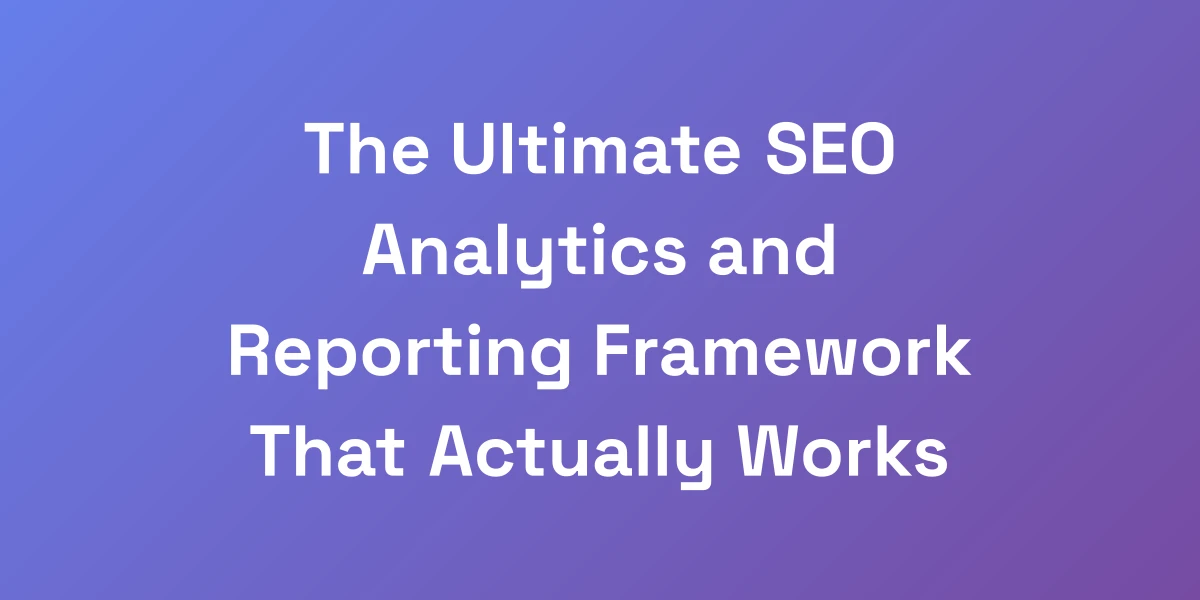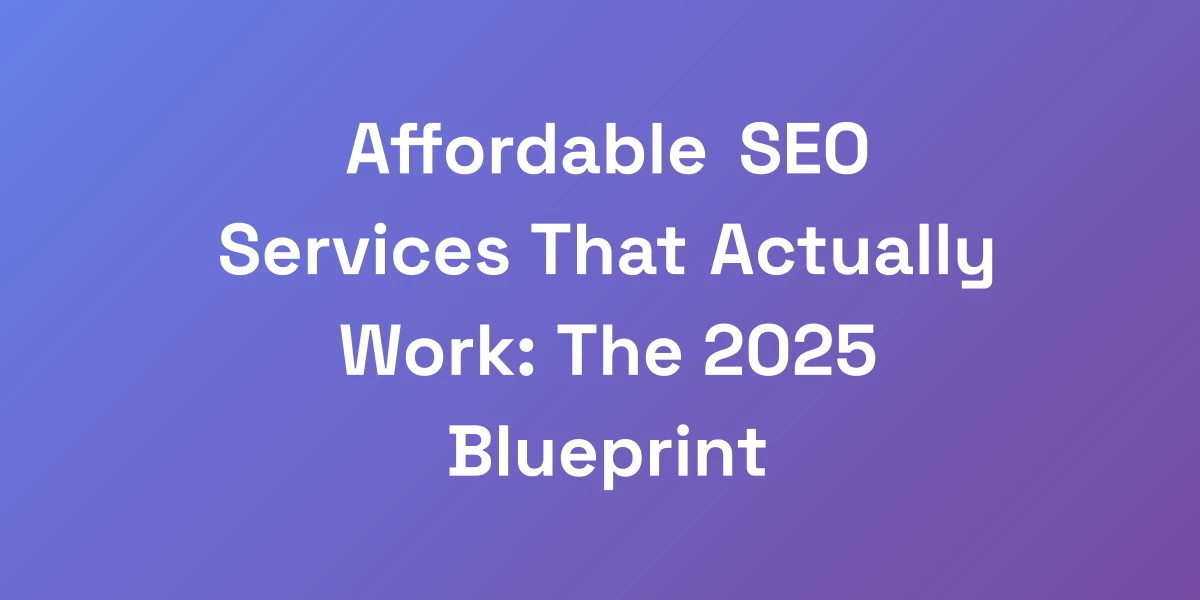
The Ultimate SEO Analytics and Reporting Framework That Actually Works
Mar 21, 2025 | By [email protected]
Why Most SEO Analytics Reports Fail (And What to Do Instead)
Let me hit you with some truth: 90% of SEO reports are complete garbage. They’re filled with vanity metrics that make you feel good but don’t move the needle.
We’ve seen countless businesses waste thousands of dollars chasing metrics that don’t matter. Here’s the deal – your SEO analytics need to focus on revenue-generating insights, not just traffic numbers.
In this guide, we’re going to show you exactly how to build an SEO reporting framework that actually drives business growth, not just pretty charts that make you feel good about yourself.
The Most Common SEO Reporting Mistakes
Why do so many SEO reports miss the mark? It’s simple: they focus on the wrong things. Let’s break down the biggest mistakes.
- Ignoring Revenue Metrics: Tracking only traffic without connecting it to revenue. Refer to SEO ROI statistics to understand the importance of revenue metrics.
- Overcomplicating Data: Presenting data in ways that confuse rather than clarify.
- Lack of Actionable Insights: Reports that tell you what happened but not what to do next. Effective stakeholder reporting ensures you have clear next steps.
- Neglecting User Intent: Failing to align metrics with what actually drives conversions.
Have you ever wondered why your reports look impressive but don’t translate to business growth? It’s because they’re not built with the right priorities in mind.
Why Traditional SEO Metrics Don’t Tell the Full Story
Traditional metrics like pageviews and bounce rates are just the tip of the iceberg. They offer a limited view of your SEO performance.
Imagine driving thousands of visitors to your site but not converting any. It’s pointless, right? That’s what traditional metrics can lead you to believe.
We need to dig deeper and look beyond the surface to understand the true impact of your SEO efforts on your bottom line.
The Revenue-First Approach to SEO Analytics
Shifting to a revenue-first approach means prioritizing metrics that directly influence your income.
Instead of just focusing on where your traffic comes from, we should be analyzing how that traffic interacts with your site to generate revenue.
This approach ensures that every SEO effort is aligned with tangible business outcomes.
Key Performance Indicators That Actually Matter
So, what KPIs should we be tracking? Here are the ones that truly matter:
- Organic Conversion Rate: The percentage of organic visitors who convert.
- Revenue per Keyword: How much revenue each keyword generates.
- User Intent Signals: Metrics that indicate if your content meets user needs.
- Conversion Path Analysis: Understanding how users move to conversion.
Tracking these KPIs provides a clearer picture of how your SEO efforts are translating into revenue. For a comprehensive SEO statistics guide, refer to our detailed resources.
Setting Up Your Analytics Infrastructure
A robust analytics infrastructure is the backbone of effective SEO reporting.
Start with integrating tools like Google Analytics, Google Search Console, SEMrush, and Ahrefs.
Ensure all data sources are properly connected to provide a comprehensive view of your SEO performance. For SEO benchmarks by industry, make sure your tools are aligned with industry standards. Additionally, utilizing automated SEO tools can enhance the accuracy and efficiency of your data collection processes.
Have you set up your analytics to collect the right data? If not, you’re missing out on crucial insights.
The Core SEO Metrics That Drive Real Business Growth
Stop wasting time tracking meaningless metrics. If you want to 10x your SEO results, you need to focus on what we call the “Money Metrics” – the key indicators that directly correlate with revenue growth.
These aren’t your typical pageviews and bounce rates. We’re talking about user intent signals, conversion path analytics, and revenue-per-keyword tracking.
These metrics will tell you exactly where to focus your efforts for maximum ROI, and we’re about to show you how to track them like pros.
Revenue-Driven SEO Metrics
Revenue-driven metrics are the cornerstone of a successful SEO strategy. Here’s what you need to track:
- Organic Conversions: Measure the number of conversions originating from organic search traffic.
- Revenue per Keyword: Identify which keywords are driving the most revenue.
- Customer Lifetime Value (CLV): Assess the long-term value of customers acquired through SEO.
By focusing on these metrics, you ensure that your SEO efforts contribute directly to your financial goals.
User Intent and Behavior Signals
Understanding user intent is crucial for aligning your content with what users are searching for.
Monitor metrics like:
- Click-Through Rate (CTR): Indicates how well your titles and meta descriptions attract clicks.
- Dwell Time: Measures how long users stay on your page.
- Bounce Rate: Tracks the percentage of visitors who leave after viewing only one page.
These signals help you refine your content to better meet user expectations and improve engagement.
Conversion Path Analysis
Conversion path analysis is about understanding the journey users take to convert.
- Identify Touchpoints: Map out all the interactions a user has with your site before converting.
- Optimize Pathways: Streamline the conversion process by enhancing key touchpoints.
- Remove Bottlenecks: Identify and eliminate obstacles that prevent users from converting.
By analyzing the conversion paths, you can optimize the user journey to increase conversion rates.
Competition Intelligence Metrics
Staying ahead of the competition requires constant monitoring of their SEO benchmarks by industry.
- Keyword Gap Analysis: Identify keywords your competitors rank for that you don’t.
- Backlink Profiles: Analyze the quality and quantity of your competitors’ backlinks.
- Content Performance: Assess which content pieces are performing best for your competitors.
These insights allow you to refine your strategy and capitalize on opportunities your competitors are missing.
Technical SEO Performance Indicators
Technical SEO is often overlooked but is crucial for ensuring your site is optimized for search engines.
- Site Speed: Faster sites provide better user experiences and are favored by search engines.
- Mobile Usability: Ensure your site is fully optimized for mobile devices.
- Indexing Status: Monitor which pages are indexed and identify any issues preventing proper indexing.
Addressing these technical aspects can significantly improve your SEO performance and user satisfaction.
Building Your SEO Analytics Dashboard for Maximum Impact
Listen, if you can’t measure it, you can’t improve it. But here’s what nobody tells you – your SEO dashboard needs to be built for action, not just information.
We’re going to show you how to create a dashboard that instantly tells you where the money is hiding in your SEO efforts.
We’re talking about real-time decision-making tools that help you identify and capitalize on opportunities before your competition even knows they exist.
Essential Dashboard Components
A powerful SEO dashboard should include the following components:
- Key Revenue Metrics: Organic conversions, revenue per keyword.
- User Behavior Indicators: CTR, dwell time, bounce rate.
- Technical SEO Stats: Site speed, mobile usability, indexing status.
- Competitive Insights: Keyword gaps, backlink profiles.
These elements provide a comprehensive view of your SEO performance and highlight areas for improvement. For examples of effective dashboards, check out SEO dashboard examples.
Data Visualization Best Practices
Effective data visualization makes your dashboard not just informative, but actionable.
- Simplicity: Avoid clutter. Use clear and concise visuals.
- Consistency: Maintain uniform styles and formats across your dashboard.
- Interactivity: Incorporate interactive elements like filters and drill-downs.
- Real-Time Updates: Ensure your data is always current to make timely decisions.
Good visualization turns complex data into understandable insights, empowering you to take immediate action.
Real-Time Monitoring Setup
Real-time monitoring is essential for staying ahead in the fast-paced world of SEO.
Set up real-time alerts for critical metrics like:
- Sudden Traffic Drops: Detect and address issues immediately.
- Ranking Fluctuations: Monitor keyword positions to stay on top of changes.
- Conversion Spikes: Identify moments of high performance and replicate success.
This proactive approach ensures you’re always informed and ready to act on important changes.
Custom Report Creation
Every business is unique, and your dashboard should reflect that.
- Tailor Metrics to Goals: Customize your dashboard to align with your specific business objectives.
- Flexible Layouts: Design layouts that adapt to different reporting needs.
- Interactive Elements: Allow users to interact with data for deeper insights.
Custom reports ensure that your SEO analytics are directly aligned with your strategic goals.
Automated Alert Systems
Automation saves time and ensures you never miss a critical update.
- Threshold-Based Alerts: Set thresholds for key metrics and receive notifications when they’re breached.
- Scheduled Reports: Automate the delivery of regular reports to stakeholders.
- Integration with Communication Tools: Use integrations with tools like Slack or email for real-time notifications.
Automated systems keep you informed without manual monitoring, allowing you to focus on strategy. To enhance these systems, consider implementing automated SEO optimization solutions that streamline your workflow and boost efficiency.
Advanced SEO Analytics Strategies for Scaling Growth
Want to know what separates six-figure SEO campaigns from seven-figure ones? It’s not just better content or more backlinks – it’s sophisticated analytics that uncover hidden opportunities.
We’re about to share the exact advanced tracking methods we use to scale our clients’ SEO results. These are the same strategies that helped us identify $2M in untapped search traffic for one of our clients.
Get ready for some game-changing insights that will transform how you approach SEO analytics. Stay updated with the latest SEO trends 2024 to ensure your strategies remain effective.
Predictive SEO Analytics
Predictive analytics involves forecasting future trends using historical data and statistical models.
- Keyword Traction Forecasting: Use tools like Google Trends and Ahrefs to predict which keywords will gain popularity.
- Content Performance Prediction: Analyze past content performance to forecast future success.
- Traffic Projections: Estimate future organic traffic based on current trends and growth rates.
By anticipating changes, you can proactively adjust your strategies to stay ahead of the curve.
Machine Learning Applications
Machine learning transforms how we analyze and interpret SEO data. Learn more about machine learning in SEO.
- Automated Keyword Research: Use machine learning to identify high-potential keywords efficiently.
- Content Gap Analysis: Machine learning algorithms can spot gaps in your content strategy by analyzing competitor content.
- User Behavior Prediction: Predict how users will interact with your site based on past behavior patterns.
These applications allow for more accurate and actionable insights, driving better SEO outcomes with the help of AI SEO tools.
Cross-Channel Attribution Modeling
Understanding how different channels contribute to conversions is crucial for optimizing your SEO efforts.
- Multi-Touch Attribution: Assign credit to multiple touchpoints in the conversion path.
- Channel Interaction Analysis: Analyze how channels like email, social media, and paid search interact with SEO efforts.
- Impact Measurement: Measure the specific impact of each channel on conversions and revenue.
This holistic view helps you allocate resources more effectively across channels.
Competitive Gap Analysis
Identifying and exploiting gaps in your competitors’ strategies can give you a significant advantage.
- Benchmarking: Compare your performance against key competitors to identify areas of improvement.
- Opportunity Identification: Find keywords and content opportunities that your competitors have overlooked.
- Strategic Adjustments: Use gap insights to refine and enhance your own SEO strategies.
Regular gap analysis ensures you remain competitive and can swiftly capitalize on new opportunities.
ROI Forecasting Techniques
Predicting the return on investment for your SEO efforts helps in making informed budget decisions.
- Historical Data Analysis: Use past performance to estimate future ROI.
- Scenario Modeling: Create different scenarios to see how various strategies might impact ROI.
- Performance Indicators: Track indicators that directly correlate with revenue growth to forecast ROI accurately.
Accurate ROI forecasting enables you to justify SEO investments and plan for sustainable growth.
Creating SEO Reports That Drive Action and Results
Your SEO reports should be profit centers, not just paperwork.
We’re going to show you how to create reports that don’t just sit in someone’s inbox – they drive immediate action and results.
We’re talking about action-oriented reporting that makes decision-making crystal clear.
When you implement this framework, you’ll see exactly what needs to be done to increase your search visibility and, more importantly, your bottom line.
Report Structure and Format
A well-structured report is easy to navigate and understand. Here’s how to structure yours:
- Executive Summary: Highlight key findings and insights.
- Detailed Metrics: Present in-depth data on core SEO metrics.
- Actionable Insights: Provide clear recommendations based on the data.
- Visual Aids: Use charts and graphs to illustrate key points.
By organizing your report this way, stakeholders can quickly grasp the most important information and understand the next steps.
Stakeholder-Specific Reporting
Different stakeholders have different needs. Tailor your reports to address these varied requirements.
- Executives: Focus on high-level metrics and ROI.
- Marketing Teams: Provide detailed insights on user behavior and campaign performance.
- Sales Teams: Highlight conversion paths and revenue-generating keywords.
Customizing reports ensures that each stakeholder receives relevant information that they can act upon.
Action Item Generation
Every report should culminate in a set of actionable items.
- Identify Opportunities: Highlight areas where improvements can be made.
- Set Priorities: Determine which actions will have the most significant impact.
- Assign Responsibilities: Clearly mark who is responsible for each action item.
This approach turns data into concrete steps, ensuring that the insights lead to tangible results.
ROI Communication
Communicating the ROI of your SEO efforts is essential for gaining and maintaining stakeholder support.
- Link Metrics to Revenue: Show how specific metrics contribute to overall revenue growth.
- Use Case Studies: Highlight successful implementations and their financial impact.
- Visualize ROI: Use graphs and charts to illustrate the return on investment clearly.
Effective ROI communication helps stakeholders see the value of SEO and continue supporting your initiatives.
Automated Reporting Systems
Automation streamlines the reporting process and ensures consistency.
- Scheduled Reports: Automatically generate and distribute reports at regular intervals.
- Integration with Communication Tools: Use integrations with tools like Slack or email for real-time notifications.
- Template Utilization: Create and use standardized templates for consistency and ease of understanding.
Automated systems save time and ensure that reports are always up-to-date and accurate.








